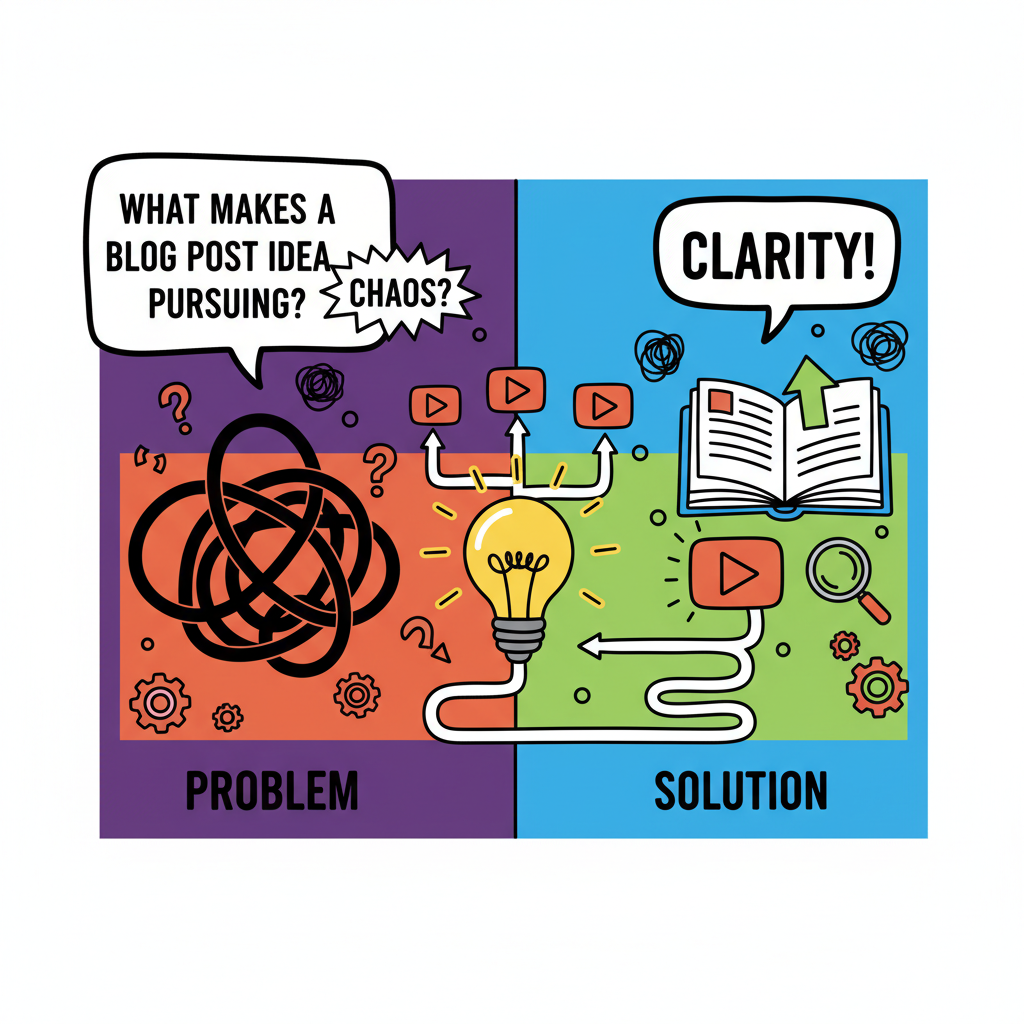What Makes a Blog Post Idea Worth Pursuing?
Posted by
How to Generate Endless Blog Post Ideas That Drive Organic Traffic

Running out of blog post ideas can feel like hitting a creative wall, especially when you're trying to maintain a consistent publishing schedule that drives organic traffic. Whether you're managing a business blog or building your personal brand, the pressure to consistently produce fresh, engaging content can be overwhelming. The good news? There are proven systems and strategies you can implement today to never run dry on compelling blog post ideas again.
In this comprehensive guide, you'll discover practical methods to generate blog post ideas that not only engage your audience but also boost your search engine rankings. We'll explore everything from audience research techniques to content gap analysis, giving you a sustainable approach to content ideation that aligns with your SEO goals.
What Makes a Blog Post Idea Worth Pursuing?

Before diving into idea generation techniques, it's crucial to understand what separates a good blog post idea from a great one. Not every topic that comes to mind deserves a spot on your editorial calendar.
A valuable blog post idea should address a specific problem your audience faces, have sufficient search volume to justify the effort, and align with your business objectives. The best ideas often emerge from the intersection of your expertise, audience needs, and market gaps. When you find topics that check all these boxes, you're setting yourself up for content that performs well both in search results and with your readers.
Additionally, consider the competitive landscape around your potential topics. While high competition might seem intimidating, it often indicates strong audience interest. The key is finding your unique angle or approaching established topics with fresh insights that differentiate your content from what's already available.
How Can You Mine Your Audience for Content Gold?
Your existing audience represents the most valuable source of blog post ideas you'll ever have access to. These are people who already engage with your brand and understand your value proposition, making their questions and concerns perfect starting points for content creation.
Start by analyzing the comments section of your existing blog posts, social media interactions, and customer support inquiries. Look for recurring questions, common pain points, and topics that generate the most engagement. These interactions provide direct insight into what your audience wants to learn about and the specific language they use to describe their challenges.
Customer interviews and surveys offer another powerful avenue for idea generation. Reach out to your most engaged customers and ask them about their biggest challenges, the resources they wish existed, and the topics they're most curious about. This direct feedback often reveals content opportunities you might never have considered otherwise.
What Questions Are Your Competitors Missing?
Competitor analysis isn't about copying what others are doing, but rather identifying gaps in the conversation that you can fill. Use tools like SEMrush or Ahrefs to analyze your competitors' content strategies and identify topics they're covering successfully.
More importantly, look for the questions they're not answering. Review their comment sections to see what readers are asking that isn't being addressed. Check their social media posts for engagement patterns and unresolved discussions. These gaps represent opportunities for you to provide value where others have fallen short.
How Do You Turn Search Data Into Content Inspiration?
Search engines provide a treasure trove of data about what people are actively looking for online. Learning to interpret and leverage this data can transform your content ideation process from guesswork into a strategic advantage.
Google's autocomplete feature offers immediate insight into popular search queries related to your topics. Start typing a broad keyword related to your industry and note the suggestions that appear. These represent real searches that people are performing, giving you direct access to their questions and interests.
The "People Also Ask" section in search results provides another goldmine of related questions. When you search for topics in your industry, Google shows you additional questions that searchers commonly have. Each of these questions represents a potential blog post idea that you know people are actively seeking answers to.
Google Trends helps you understand the seasonal patterns and growing interest around specific topics. This tool can help you time your content publication for maximum impact and identify emerging trends before they become oversaturated with content.
| Research Method | Time Investment | Idea Quality | Implementation Difficulty |
|---|---|---|---|
| Audience Surveys | High | Very High | Medium |
| Search Autocomplete | Low | High | Easy |
| Competitor Analysis | Medium | High | Medium |
| Social Media Listening | Medium | Medium | Easy |
| Keyword Research Tools | Medium | Very High | Hard |
What Role Does Your Industry Calendar Play in Content Planning?

Every industry has predictable cycles, seasonal trends, and recurring events that create natural content opportunities. Building your blog post ideas around these patterns ensures your content remains timely and relevant to your audience's current needs.
Start by mapping out the major events, conferences, product launches, and seasonal trends in your industry. For each significant date or period, brainstorm related topics that your audience might be interested in. This approach helps you plan content well in advance while ensuring it aligns with when people are most likely to be searching for related information.
Don't forget about broader cultural moments and holidays that might intersect with your industry. Even B2B companies can find creative ways to tie their expertise into widely recognized events, creating content that feels both timely and valuable. The key is finding authentic connections rather than forcing relevance where none exists.
Understanding what makes organic traffic different from other traffic sources can help you prioritize topics that will drive long-term, sustainable results rather than short-term traffic spikes.
How Can You Repurpose and Expand Existing Content?
Your existing content library contains numerous opportunities for new blog post ideas if you know how to look for them. Every piece of content you've created can potentially be expanded, updated, or viewed from a different angle to create fresh material.
Look at your top-performing blog posts and consider how you can dive deeper into specific points you mentioned briefly. A single paragraph in a comprehensive guide might contain enough material for an entire dedicated post. Similarly, if you've covered a topic at a high level, consider creating more detailed, tactical content that helps readers implement your suggestions.
User-generated content and case studies provide another avenue for content expansion. When customers share success stories or interesting applications of your products or advice, these real-world examples can become the foundation for detailed blog posts that showcase practical implementation.
What About Trending Topics and News Jacking?
Staying current with industry news and trending topics can provide a steady stream of timely blog post ideas. However, the key to successful news jacking lies in adding genuine value rather than simply commenting on current events.
When industry news breaks, consider how it impacts your audience specifically. What questions might they have? How does this development change best practices in your field? What opportunities or challenges does this create for businesses like theirs? By focusing on the practical implications rather than just the news itself, you create content that remains valuable long after the initial buzz dies down.
How Do You Validate Ideas Before Investing Time in Creation?
Not every blog post idea deserves the full treatment of research, writing, and promotion. Developing a system for quickly validating ideas can save you significant time and ensure your efforts focus on content with the highest potential for success.
Start by checking search volume and competition levels for your target keywords. Tools like Google Keyword Planner or Ubersuggest can give you a sense of whether enough people are searching for your topic to justify the investment. However, don't dismiss low-volume keywords entirely, especially if they're highly specific to your niche or represent emerging trends.
Consider the shareability and discussion potential of your ideas. Topics that naturally invite debate, provide actionable advice, or solve common problems tend to generate more engagement and social shares. Think about whether your idea gives readers something concrete they can implement or share with their networks.
Social media can serve as a testing ground for blog post ideas. Share your concept as a social post and gauge the response. High engagement levels often indicate that a full blog post on the topic would resonate with your audience.
What Systems Keep Your Idea Pipeline Full?

Sustainable content creation requires systems that continuously feed your idea pipeline without requiring constant active effort. Building these systems upfront creates a foundation for consistent publishing that doesn't rely on last-minute inspiration.
Create a centralized system for capturing ideas as they occur to you throughout the day. Whether it's a note-taking app, a dedicated email folder, or a physical notebook, having a consistent place to record thoughts ensures good ideas don't slip away. Review and organize these captured ideas regularly, categorizing them by topic, priority, or publication timeline.
Set up Google Alerts for key terms in your industry to receive regular updates about trending topics and discussions. This passive monitoring system helps you stay informed about developments that might inspire content without requiring active research time.
Developing relationships with others in your industry can provide ongoing inspiration and collaboration opportunities. Join professional groups, attend virtual events, and engage in industry discussions. These interactions often reveal pain points and questions that translate directly into valuable blog post ideas.
Learning what makes organic SEO tips different from generic SEO advice will help ensure your content ideas align with strategies that build lasting search visibility.
How Do You Balance Evergreen and Trending Content?
A successful blog post idea strategy balances evergreen content that remains valuable over time with timely pieces that capitalize on current trends and discussions. This balance ensures steady organic traffic growth while maintaining relevance and engagement with your audience.
Evergreen content forms the foundation of your content strategy. These pieces target fundamental questions and challenges in your industry that don't change significantly over time. They continue attracting organic traffic months or years after publication, making them excellent investments of your time and resources.
Trending content, while shorter-lived, can drive significant traffic spikes and social engagement when executed well. The key is identifying trends early enough to create thoughtful content before the topic becomes oversaturated. According to Content Marketing Institute's research, successful content strategies typically consist of 70% evergreen content and 30% timely pieces.
Understanding what does it really take to build sustainable organic traffic can guide your decisions about which types of content to prioritize in your editorial calendar.
Conclusion
Generating consistent blog post ideas doesn't have to be a constant struggle. By implementing the systematic approaches outlined in this guide, you can build a sustainable pipeline of content ideas that serve both your audience's needs and your SEO objectives. Remember that the best ideas often come from genuinely understanding your audience's challenges and staying curious about developments in your industry.
Start by choosing two or three of these techniques that resonate most with your current situation and available resources. As these become habitual parts of your content planning process, you can gradually incorporate additional methods to further strengthen your idea generation capabilities.
Ready to transform your content strategy with ideas that drive real organic traffic? Explore how Fast SEO Fix can help you implement these content ideation strategies as part of a comprehensive approach to search engine optimization that delivers measurable results for your business.